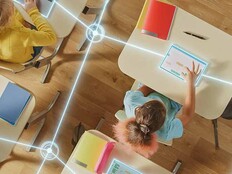The Tools of the Trade
A school's mission to educate students and have a positive influence on their lives never changes. But a lack of education funding has made accomplishing those goals more challenging. Still, budgetary obstacles notwithstanding, school leaders are making sure students have the tools they need to succeed.
CDW•G's recent 21st Century Classroom Report, an annual survey of students, teachers and IT professionals about the role and use of technology in education, found that 65 percent of districts are planning new IT investments over the next two years — even though nearly half of surveyed IT managers reported that their budgets have decreased for the 2011–2012 school year. As the districts featured in "Leaps and Bounds" on Page 18 reveal, rolling out the classroom technologies that make learning come alive for students can be achieved with a bit of creativity.
Dr. Christine Coleman is doing just that for the City School District of New Rochelle in New York by piloting and implementing these tools in phases over several years using both district and federal funding. Today, every classroom in the district has a computer for the instructor, an interactive whiteboard, a projector and a laser printer.
In addition to computer and mobile labs, New Rochelle offers specialized labs full of technology, including a lab to learn networking through the Cisco Networking Academy and a graphics design lab with Quark and Adobe software.
In Yuma, Ariz., Dean Farar also is taking an incremental approach, spending "a little here and there" to help move his districts "toward a standard toolset." Farar is director of technology for the Yuma Educational Technology Consortium (YETC), which manages IT for the Yuma Union High School District and Yuma School District One.
To save money, cut down on software licensing costs and improve security, the Yuma Union High School District standardized on ASUS netbooks running the Linux operating system, as well as open-source office productivity software.To brace for the influx of mobile devices, YETC installed a wireless network throughout all of its K–12 schools over the past few years, Farar adds.
A Learning Experience
Districts are getting equally creative when it comes to teaching tech skills to both educators and students. The Teacher Student Support group for Baltimore City Public Schools, for example, has created "Retool Your School," a professional development model through which teachers meet one on one with instructional technologists to learn how to incorporate new tools into their lesson plans.
To participate in the program, which is still in the early stages, principals are required to commit to use technology in their jobs and to attend professional development opportunities themselves. The tech-support team's hope is that as these principals become excited about the program, they will tell other principals in the district, who will show similar enthusiasm. That way, the tech-support team won't have to sell principals on the program at all — it will be something they anticipate and perhaps even look forward to.
For more on how schools are incorporating professional development into their technology programs, see "Team Effort."
Meanwhile, the Cincinnati-based Oak Hills Local School District has come up with a program, dubbed eKIDs, through which students learn new technologies, teach them to their classmates and then work with teachers to incorporate them into the existing curriculum. To learn more about the program, turn to "Kid Power."
These are just some of the ways in which schools are innovating in the face of economic uncertainty and increased scrutiny from stakeholders, both inside and outside their classrooms. Keep reading for more ideas.

Ryan Petersen
EDITOR IN CHIEF








